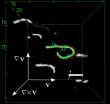Discovery may lead to lower doses of chemotherapy
2014-10-09
(Press-News.org) No matter what type of chemotherapy you attack a tumor with, many cancer cells resort to the same survival tactic: They start eating themselves.
Scientists at Brigham Young University discovered the two proteins that pair up and switch on this process – known as autophagy.
"This gives us a therapeutic avenue to target autophagy in tumors," said Josh Andersen, a BYU chemistry professor. "The idea would be to make tumors more chemo-sensitive. You could target these proteins and the mechanism of this switch to block autophagy, which would allow for lower doses of chemotherapy while hopefully improving patient outcomes."
Lower doses would mean milder side effects. The prospect spurred an international hunt for this switch. For good reason, several other labs started with a protein called ATG9 as their prime suspect and then looked for its accomplice among thousands of other proteins.
But the BYU team, comprised mainly of undergraduate students, stumbled into the race unexpectedly, coming at it from a different direction. They wanted to know why cancer cells made a surplus of protein called 14-3-3 zeta.
Using breast cancer tissue in the lab, they forced tumor cells to undergo autophagy by depriving them of oxygen and glucose. A comparison with a control group let them see that the two proteins hook up only when under attack. That's because stress makes Atg9 undergo a modification that enables 14-3-3 zeta to bind with it and switch the cancer cells to survival mode.
"This unique approach we used, partially by luck, gave us an advantage," Andersen said. "I don't think we would have discovered this through more conventional approaches."
The study results appear in the journal Molecular and Cellular Biology.
Andersen notes that several medicines already exist that could block autophagy and make chemotherapy more effective. One of them is called chloroquine, an anti-malarial drug invented in 1934. In the event that this and other existing inhibitors don't cross-over safely or effectively, the study offers a blueprint for development of a drug specific to the task.
INFORMATION:
Ph.D. candidate Vajira Weerasekara directed the lab experiments and co-authored the study. Undergraduate students David Panek and David Broadbent also made significant contributions to the research and appear as co-authors. When they complete their degrees at BYU, Weeraskara will re-join the faculty at the University of Colombo in Sri Lanka, Panek will go to medical school, and Broadbent will pursue a joint M.D. and Ph.D. program.
Mentored research is a large reason why BYU ranks so highly as a Ph.D. launch pad. According to the National Science Foundation, BYU ranks 5th in the nation for the number of graduates who go on to earn doctorate degrees.
Professor David Thomson in BYU's physiology and developmental biology department collaborated on the research.
ELSE PRESS RELEASES FROM THIS DATE:
2014-10-09
The evolution of new traits with novel functions has always posed a challenge to evolutionary biology. Studying the color markings of cichlid fish, Swiss scientists were now able to show what triggered these evolutionary innovations, namely: a mobile genetic element in the regulatory region of a color gene. Their results have been published in the latest issue of the renowned scientific journal Nature Communications.
Biological evolution is in general based on the progressive adaption of traits through natural or sexual selection. However, ever so often, complex traits ...
2014-10-09
Ebola, as with many emerging infections, is likely to have arisen due to man's interaction with wild animals – most likely the practice of hunting and eating wild meat known as 'bushmeat'. A team of researchers led by the University of Cambridge and the Zoological Society of London (ZSL) has surveyed almost six hundred people across southern Ghana to find out what drives consumption of bat bushmeat – and how people perceive the risks associated with the practice.
The Straw-Coloured Fruit Bat, Eidolon helvum, is widely hunted and eaten in Ghana, but carries ...
2014-10-09
Carbon capture is a process by which waste carbon dioxide (CO2) released by factories and power plants is collected and stored away, in order to reduce global carbon emissions. There are two major ways of carbon capture today, one using powder-like solid materials which "stick" to CO2, and one using liquids that absorb it. Despite their potential environmental and energy benefits, current carbon capture strategies are prohibitive because of engineering demands, cost and overall energy-efficiency. Collaborating scientists from EPFL, UC Berkley and Beijing have combined carbon-capturing ...
2014-10-09
Jülich, Germany, 9 October 2014 – When a basically sturdy material becomes soft and spongy, one usually suspects that it has been damaged in some way. But this is not always the case, especially when it comes to complex fluids and biological cells. By looking at the microscopic building blocks – known as "filaments" – of biopolymer networks, researchers from Forschungszentrum Jülich, Germany and the FOM Institute AMOLF in the Netherlands, revealed that such materials soften by undergoing a transition from an entangled spaghetti of filaments to ...
2014-10-09
Some 340 European scientists, policy-makers and other experts representing 143 organizations from 31 countries spoke with one voice today, publishing a common vision of today's most pressing marine-related health and economic threats and opportunities.
In a declaration concluding a three day meeting in Rome, EurOcean 2014 participants also released an agreed, five-year roadmap to achieve expanded, more integrated and effective policy-oriented ocean scrutiny.
EurOcean 2014 was convened by the Italian Presidency of the Council of the European Union, the European Marine ...
2014-10-09
Nyon, Switzerland (October 9, 2014) – Alarming new data published today by the International Osteoporosis Foundation (IOF), shows that one-third of all hip fractures worldwide occur in men, with mortality rates as high as 37% in the first year following fracture. This makes men twice as likely as women to die after a hip fracture. Osteoporosis experts warn that as men often remain undiagnosed and untreated, millions are left vulnerable to early death and disability, irrespective of fracture type.
The report entitled 'Osteoporosis in men: why change needs to happen' ...
2014-10-09
(PHILADELPHIA) -- The genetic fingerprint of a metastatic cancer is constantly changing, which means that the therapy that may have stopped a patient's cancer growth today, won't necessarily work tomorrow. Although doctors can continue to biopsy the cancer during the course of the treatment and send samples for genomic analysis, not all patients can receive repeat biopsies. Taking biopsies from metastatic cancer patients is an invasive procedure that it is frequently impossible due to the lack of accessible lesions. Research published October 10th in the journal Breast ...
2014-10-09
When a woman is in labour, the appropriate time to give an epidural during childbirth is when she asks for it, a new study suggests. Published in The Cochrane Library, the systematic review compared early and late epidurals during labour and found that they had very similar effects.
An epidural is a pain relieving local anaesthetic that is given as an injection into the spine. It is commonly offered to women in labour who request pain relief and is effective in reducing pain. However, previous studies have suggested that the timing of an epidural can prolong the duration ...
2014-10-09
New research published in Diabetologia (the journal of the European Association for the Study of Diabetes) shows that women who eat fried food regularly before conceiving are at increased risk of developing gestational diabetes during pregnancy. The research is led by Drs Cuilin Zhang and Wei Bao, Eunice Kennedy Shriver National Institute of Child Health and Human Development (NICHD, part of the US National Institutes of Health) Rockville, MD, USA, and colleagues.
Gestational diabetes (GDM) is a complication that can arise during pregnancy, and is characterised by abnormally ...
2014-10-09
Online learning interventions and small group debriefings can improve medical residents' attitudes and communication skills toward patients with substance use disorders, and may result in improved care for these patients, according to a new study from the Perelman School of Medicine at the University of Pennsylvania and Drexel University College of Medicine published online in Academic Medicine.
The study used a novel internet-based learning module designed to improve the communication skills of primary care physicians during screenings and brief counseling sessions with ...
LAST 30 PRESS RELEASES:
[Press-News.org] Discovery may lead to lower doses of chemotherapy


